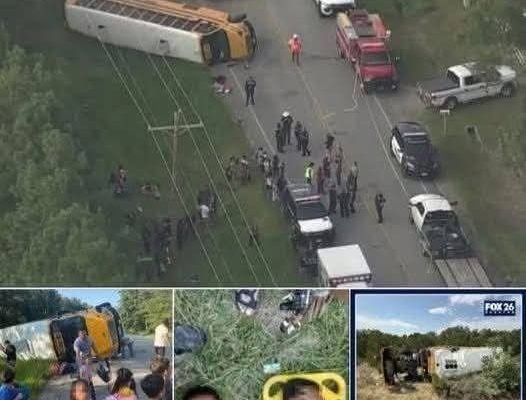Eight years ago, Tanzania faced one of the darkest days in its modern history—a tragedy that shattered families, silenced classrooms, and brought a nation to its knees. On May 6, 2017, a school bus carrying children from Lucky Vincent Primary School in Arusha lost control on a slippery mountain road in the Karatu district. The crash claimed the lives of 32 children, two teachers, and the driver. The accident remains one of the deadliest in the country’s history, and even now, in 2025, the grief still lingers.
That morning had begun with pride and excitement. The children were on their way to take a mock national exam—something they had worked toward for months. Teachers encouraged them to do their best; parents sent them off with hugs and smiles, never imagining it would be the last time they’d see their faces.
The road to Karatu was known to be treacherous, winding through hills often slick with rain. Witnesses later recalled how the bus struggled to maneuver around a sharp bend before skidding off the wet pavement. It plunged into a ravine, rolling several times before coming to rest in a twisted heap of metal. When rescuers arrived, they were met with silence—the kind that only comes after the unimaginable.
News of the accident spread across Tanzania like wildfire. Radio and television stations interrupted regular programming; newspapers printed black-bordered headlines. The entire country went into mourning. President John Magufuli declared a national day of grief, and citizens across all regions held vigils and prayer gatherings for the victims.
In Arusha, parents crowded hospitals and morgues, clinging to a fading hope that their children might still be alive. One mother described recognizing her daughter only by the bracelet she had made at school. Another father fainted when he saw his son’s backpack among the wreckage. The pain was too vast to measure.
And yet, amid the devastation, a miracle emerged. Three students—Wilson, Sadia, and Doreen—were found alive. Severely injured but breathing, they were airlifted to the hospital. Their survival became a rare light in a sea of loss. Later, with international support, they were flown to the United States for advanced medical treatment. Their recovery captured the world’s attention, symbolizing courage, resilience, and the strength of the human spirit.
The incident sparked nationwide conversations about road safety and accountability. The government pledged immediate reforms: stricter driver licensing requirements, enhanced training for school transport operators, and improved road infrastructure—particularly in rural regions where poor maintenance had long been ignored. For a while, public awareness soared. Road safety campaigns filled the airwaves, and for a moment, change felt possible.
But as the years passed, the momentum slowed. Some reforms took hold; others faded into bureaucracy. Still, the Karatu tragedy became a permanent reference point—a lesson written in loss. Every time news of another road accident broke, people remembered those 32 faces. Their story had become part of Tanzania’s collective memory.
Today, at the memorial site near the crash location, flowers and school uniforms still appear each May. Families travel from across the country to stand together in quiet reflection. Teachers and students from Lucky Vincent Primary School make the pilgrimage annually, reading the names aloud one by one. Each name carries a story—children who loved football, drew animals, dreamed of becoming doctors, pilots, or teachers.
The survivors, now teenagers, have carried their own complex legacy. They’ve grown stronger, but the weight of being “the ones who lived” never leaves. Sadia, one of the survivors, said in an interview last year, “I still see their faces sometimes. I think we survived for a reason—to keep their memory alive.”
The school itself has changed. New safety protocols are in place: drivers undergo monthly evaluations, seat belts are mandatory, and every journey includes a pre-departure inspection. There’s also a scholarship fund in the victims’ names, ensuring that students from low-income families can continue their education—something many of those lost children had once dreamed of.
Parents of the victims remain bound together by their grief and their determination to see that no family ever experiences the same pain. They’ve formed support groups, lobbied for improved roads, and met with lawmakers to push for action. Many have turned mourning into movement.
Still, the passage of time has not dulled the ache. The empty chairs at home, the untouched school notebooks, the memories of laughter that once filled hallways—all remain as reminders of a day that changed everything.
Eight years later, Tanzania continues to ask hard questions: How do we protect our children on roads that weren’t built for safety? How do we ensure accountability in a system too often numbed by tragedy? And most importantly—how do we heal?
Healing, as it turns out, looks different for everyone. For some, it’s planting a tree at the memorial. For others, it’s volunteering in road safety programs or visiting the crash site each year to leave flowers and prayers. For the survivors, it’s about honoring the lives that ended so that theirs could continue.
The Karatu tragedy taught the nation that grief and resilience can coexist. It showed how quickly life can be undone, but also how deeply people can come together when it matters most.
In the years since, Tanzania has faced other challenges—pandemics, economic struggles, political shifts—but none have erased the shared sorrow of May 6, 2017. It remains a national wound and a reminder that progress, like healing, requires vigilance and compassion.
At the memorial site, a simple plaque bears the names of the lost and an inscription that reads: “They went to learn and became our teachers.”
It’s true. Their lives, though short, reshaped an entire country’s understanding of safety, responsibility, and love. Their loss became a lesson in vigilance and unity.
Eight years later, the flowers at Karatu are still fresh, replaced again and again by hands that refuse to forget. The tears may have slowed, but the memory stands eternal—a generation gone too soon, leaving behind a promise that Tanzania continues to honor: to never let their story fade.
The pain has softened with time, but the lesson endures. When we remember them, we are reminded that the cost of negligence is measured not in statistics, but in names, faces, and dreams left unfinished.
The children of Karatu were more than victims—they were the heartbeat of a nation that, even in mourning, found the courage to hope again.



